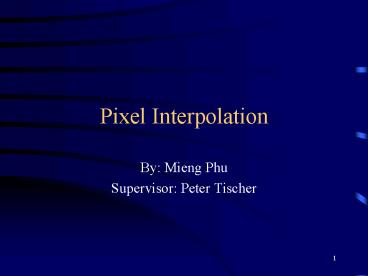Pixel Interpolation - PowerPoint PPT Presentation
1 / 25
Title: Pixel Interpolation
1
Pixel Interpolation
- By Mieng Phu
- Supervisor Peter Tischer
2
Outline
- Pixel Interpolation and Background
- Scenarios
- Interpolation Techniques
- Test Data
- Results and Discussions
- Future Work
- Summary
3
Pixel Interpolation
- Predicting/interpolating missing values occurs in
many areas of image processing, especially in
lossless image coding. - The idea of this project is to take the
prediction techniques from lossless image coding
and apply them to other area of image/video
processing.
4
Scenarios in Video/Image Processing
- Deinterlacing within a single field (spatial)
- Deinterlacing in two fields (spatial and
temporal) - Deinterlacing in three fields (spatial and
temporal) - Convert from SDTV to HDTV (Magnification)
5
X- known value
? - unknown value
Scenario One (1 field)
Scenario Two (2 fields)
6
Scenario Three (3 fields)
7
Terminology
- Neighboring pixels
8
Interpolation Techniques(1)
- Scenario One Predictors (Prediction within a
single field or on still image). - Line doubling
- Averaging, e.g. (NS)/2, (NWNNESWSE)/2
- Median filter.
- Pseudo Median (PMED) - H-Shape, A-Shape,
Adaptive. - ELA, Adaptive ELA, ELA (Tao Chen).
- Some of my proposed algorithms.
9
Interpolation Techniques(2)
- Edge Line Averaging (ELA)
- Adaptive - ELA (A-ELA)
- The concept is the same as ELA, but it uses a
unique way to detect a horizontal edges.
10
Interpolation Techniques(3)
- ELA Chen, Henry, et al.
- Used two additional measurements to determine the
direction correlations. - Hence, good predictor for a 630 edges from the
horizontal.
11
Interpolation Techniques(4)
- Median Filter
- Median10,10,10,10,100,100
- Pseudo Median (by definition)
Segment 1
Segment 2
PMED a, b, c, d, e, f 0.5 x max min of each
sub window 0.5 x min max of each sub window
12
Interpolation Techniques(5)
- For scenario two and three predictors
- Interpolation techniques in situation scenario
one can be generalized in situation two and three.
? h ? (b h e)/3 ? median (b, h, e,)
? PMED a, b, c, d, e, f, h
13
? (h k)/2 ? Median h, k, (be)/2 ? PMED
a, b, c, d, e, f, h, k
14
Test Data
- Standard natural Images
- Synthetic Images
- Lines with different orientations
- Different textures
- Video sequences
- Different speeds of motion between fields.
- Textures edges, lines etc.
15
Scenario1 Results(1)
16
Scenario1 Results(2)
- H-Shaped PMED
- Best predictor overall
- Superb in detection of
- vertical edges.
H-Shaped PMED a, b, c, d, e, f 0.5 x
maxmina,b,c,,mind,e,f,minb,e 0.5 x
minmaxa,b,c,maxd,e,f,maxb,e
17
Scenario1 Results(3)
- LD - 21.61 dB
- ELA - 19.26 dB
- A-ELA - 19.16 dB
- ELA (CHEN) - 24.99 dB
- But even better results
- H-Shaped - 25.27 dB
- CHEN PMED - 25.22 dB
18
Scenario1 Results(4)
- CHEN PMED is a combination of the PMED and ELA
(Chen). - It use ELA(Chen) to select the PMED subwindows.
- Like ELA(Chen), it predict well for edges at an
orientation of 630. - This algorithm perform better than ELA(Chen) in
wide range of images.
19
Scenario1 Results(5)
- The median a, b, c, d, e, f, (be)/2
- Can have the
- median a, b, c, d, e, f, (be)/2, (ab)/2,
(bc)/2, (de)/2, (ef)/2 - Furthermore, you can further subdivide into
half-pel, quarter-pel, or even further. - This approach is proven to be better than the
generic median filter. But more computation.
20
Scenario1 Results(6)
- A-ELA can detect horizontal lines incredible
well. - A-ELA 39.7 dB
- H-Shaped 25.7 dB
- ELA(CHEN) - 25.7dB
- A-ELA - 13.15 dB
- H-Shaped - 8.47 dB
- ELA(CHEN) 8.45 dB
21
Scenario1 Results(7)
Football (64 frames). 352x240
Flower Garden (64 frames). 352x288
Akiyo (10 frames). 352x288
22
(No Transcript)
23
Conclusions
- ELA (Chen) is good for detection of diagonal
edges. - ELA (Chen) can be improved by using PMED or
Median filter. - H-Shaped PMED can detect the vertical edges well,
and perform best overall. - A-ELA is really good at detect the horizontal
lines. - Median filter can be improved by using the right
group of pixels. - Average 2, give good results and for little
computation.
24
Future Work
- Potential algorithms in scenario one can be
improved. - Combine H-Shaped, ELA(CHEN) and A-ELA together,
to form the best predictor. - More generalization can be made on two and three
fields. - Magnifications
25
Questions?






























